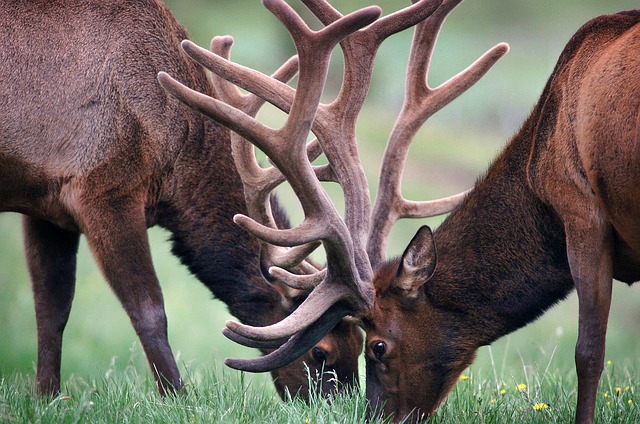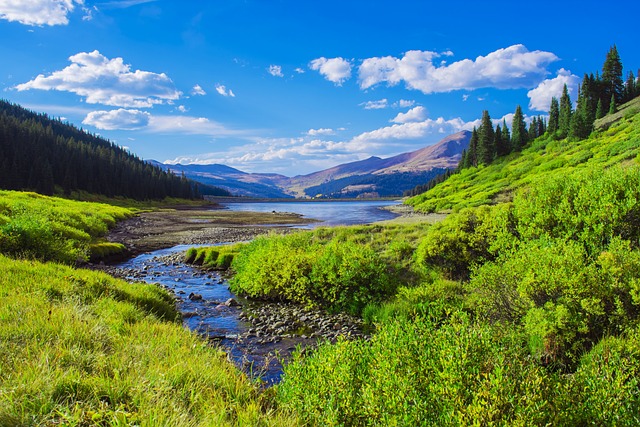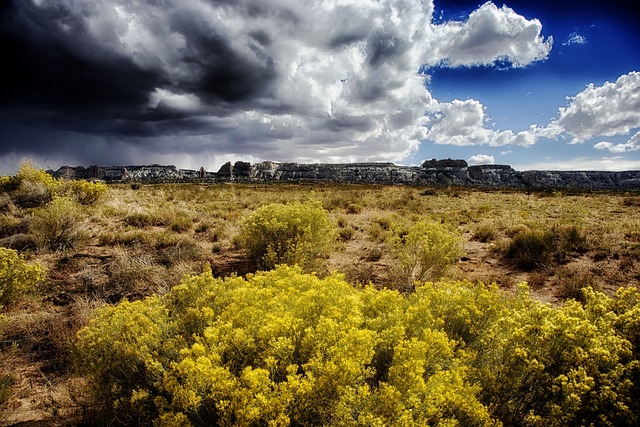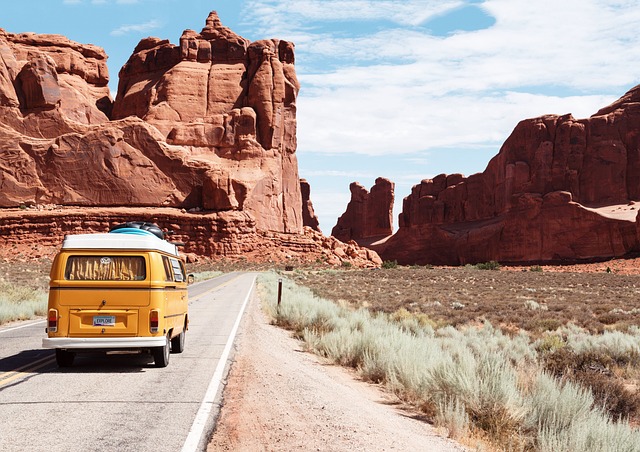Colorado is a state rich in natural beauty, cultural heritage, and innovative agricultural practices. It boasts iconic geological features like the Maroon Bells-Snowmass Wilderness and Pikes Peak, with the latter being known as "America's Mountain" and reaching 14,115 feet. These landscapes offer stunning vistas and serve as a playground for outdoor enthusiasts and a testament to Colorado's enduring spirit of exploration. The state's high elevation, at an average altitude of one mile, influences its unique climate and the daily lives of its residents, affecting everything from athletic performance to health. Denver exemplifies this elevation impact. Colorado's cultural landscape is a vibrant mix of Indigenous traditions, Hispanic heritage, and the rugged American West ethos, with historical events like the Colorado-Spanish War highlighting their coexistence and conflicts. The state celebrates its multicultural identity through festivals, art, and living history events, preserving its cultural narrative. In addition to its cultural richness, Colorado is a leader in sustainable agriculture, integrating cutting-edge farming techniques with regenerative practices that prioritize soil health, biodiversity, and carbon sequestration. The state's farms are also at the forefront of adopting renewable energy, making it a beacon for sustainable innovation in American agriculture. Colorado's diverse environments, from its agricultural heartlands to its majestic Rocky Mountains, make it a unique and captivating destination that harmonizes natural splendor with cultural depth and innovative agricultural practices.
Explore the Centennial State through a lens of wonder as we unveil the myriad facets that make Colorado an enigma wrapped in a riddle, cloaked in beauty. From the towering peaks of the Rocky Mountains to its vibrant cultural mosaic and pioneering agricultural practices, this article delves into the heart of Colorado’s unique geological wonders, its distinct altitude influence on Denver, and the rich tapestry of its cultural heritage. Join us as we traverse the diverse landscapes and innovative farming sectors that set Colorado apart, offering a glimpse into what makes it an exceptional place within the United States.
- Colorado's Unique Geological Wonders: From the Mesmerizing Maroon Bells to the Mighty Pikes Peak
- The Mile-High State: Understanding Denver and Colorado's Distinct Altitude
- Colorado's Rich Cultural Tapestry: A Blend of Indigenous, Hispanic, and Western Heritage
- Colorado's Agricultural Diversity: Leading the Way in Sustainable Farming and Innovation
Colorado's Unique Geological Wonders: From the Mesmerizing Maroon Bells to the Mighty Pikes Peak

Colorado’s geological diversity is a marvel that ranges from the majestic Maroon Bells to the iconic Pikes Peak. The Maroon Bells-Snowmass Wilderness, often hailed for its breathtaking beauty, offers visitors a glimpse into a landscape shaped by glaciers and time. With its twin peaks, Maroon and North Maroon, standing at over 14,000 feet, these formations are among the most photographed in North America, their distinctive bell shapes outlined against the backdrop of Colorado’s azure skies. The area’s reflection in the clear waters of Maroon Lake is a serene spectacle that captures the hearts of photographers and nature enthusiasts alike.
Moving beyond the enchanting beauty of the Maroon Bells, one can’t help but be awestruck by Pikes Peak, known as “America’s Mountain.” Rising to a height of 14,115 feet, it is not only a geological wonder but also a testament to human exploration and resilience. Climbed for the first time in 1820 by two men on horseback, Zebulon Pike and his guide, the peak has since drawn countless adventurers seeking its summit. Pikes Peak is not just a geological feature; it’s a symbol of Colorado’s rich history and its enduring allure for those who seek to challenge themselves against its steep inclines. Whether experienced up close on foot or viewed from afar, the grandeur of these natural wonders is an integral part of Colorado’s identity and a must-see for any visitor to the state.
The Mile-High State: Understanding Denver and Colorado's Distinct Altitude

Colorado, known as the Mile-High State, boasts a unique altitude that shapes its geography, climate, and the daily lives of its residents. The capital city, Denver, sits precisely one mile above sea level, offering both breathtaking views and a host of physiological effects on visitors and locals alike. This high-altitude environment influences everything from athletic performance to barometric pressure readings. Tourists flock to Colorado for its renowned ski resorts, yet they must acclimatize to the thinner air to avoid altitude sickness. The state’s geography is characterized by the Rocky Mountains, which not only provide stunning landscapes but also affect the local climate, leading to significant variations in weather patterns between the mountains and the plains. Colorado’s altitude is a defining feature that contributes to its distinct culture and recreational opportunities, making it a state unlike any other in the nation.
Colorado's Rich Cultural Tapestry: A Blend of Indigenous, Hispanic, and Western Heritage

Colorado’s rich cultural tapestry is a vibrant blend of Indigenous, Hispanic, and Western heritage, creating a multifaceted cultural experience that is uniquely Coloradoan. The state’s indigenous peoples, including the Ute, Arapaho, and Cheyenne, have a long history and continue to contribute significantly to Colorado’s culture. Their traditions, beliefs, and knowledge of the land are deeply integrated into the modern tapestry. The arrival of Spanish explorers and settlers introduced new influences, with Hispanic culture leaving an indelible mark through its language, cuisine, and festivals. This fusion is most notably seen in the Colorado-Spanish War of 1878, which reflects both conflict and coexistence between cultures.
The western heritage of Colorado is equally influential, shaped by the gold rush, cattle ranching, and the broader American frontier narrative. The state’s numerous historic towns and sites, such as the Silk Stocking Cowgirls and the Denver Westerners, showcase this legacy through museums, rodeos, and living history events. Today, this cultural blend is celebrated across Colorado, from the vibrant streets of Denver to the small communities nestled in its mountainous regions. The state’s festivals, art galleries, and community gatherings all serve as platforms where these distinct heritages come together, creating a rich, dynamic, and ever-evolving cultural experience that is both authentic and diverse. Colorado’s cultural tapestry is a testament to the resilience and adaptability of its people, as well as a reminder of the importance of preserving the unique contributions of each heritage.
Colorado's Agricultural Diversity: Leading the Way in Sustainable Farming and Innovation

Colorado’s agricultural landscape is a mosaic of innovation and tradition, showcasing the state’s commitment to sustainable farming practices. With its diverse climate zones ranging from high plains to alpine forests, Colorado farmers and ranchers have adapted to harness the unique conditions for cultivating a wide array of crops. These include the staples of corn and wheat, as well as specialty crops like lavender, olives, and hops, which are gaining popularity in the craft beer industry. The state’s agricultural sector is a leader in implementing cutting-edge technologies such as precision agriculture, which optimizes resource use and minimizes environmental impact. Colorado’s farmlands are also pioneers in regenerative agriculture, aiming to rehabilitate the land while producing food, fostering biodiversity, and enhancing carbon sequestration. This forward-thinking approach not only ensures the longevity of the state’s fertile lands but also positions Colorado as a model for sustainable agricultural practices nationwide. The integration of renewable energy sources on farms further exemplifies Colorado’s dedication to sustainable innovation, demonstrating that agriculture and environmental stewardship can coexist and thrive together.
Colorado’s allure lies not only in its towering geological wonders and rich cultural tapestry but also in its pioneering spirit in agriculture, setting a benchmark for sustainable practices. From the iconic Maroon Bells to the storied Pikes Peak, and from the bustling streets of Denver to the vibrant fusion of Indigenous, Hispanic, and Western traditions, Colorado’s diverse offerings are a testament to its unique place in the United States. As the article has explored, the Centennial State is more than just a destination; it’s a living mosaic that invites exploration and appreciation of its natural beauty, cultural depth, and innovative agricultural practices. Whether you’re an outdoor enthusiast or a culture seeker, Colorado promises a multifaceted experience that is as enriching as it is unforgettable.
